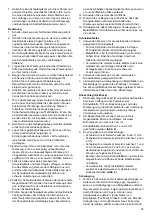
13
FUNCTIONAL DESCRIPTION
WARNING:
•
Always be sure that the tool is switched off and
battery cartridge is removed before adjusting or
checking the functions on the tool.
Failure to switch
off and remove the battery cartridge may result in
serious personal injury from accidental start-up.
Installing or removing battery cartridge
(Fig. 4)
CAUTION:
• Always switch off the tool before installing or removing
of the battery cartridge.
•
Hold the tool and the battery cartridge firmly when
installing or removing battery cartridge.
Failure to
hold the tool and the battery cartridge firmly may cause
them to slip off your hands and result in damage to the
tool and battery cartridge and a personal injury.
To remove the battery cartridge, slide it from the tool while
sliding the button on the front of the cartridge.
To install the battery cartridge, align the tongue on the
battery cartridge with the groove in the housing and slip it
into place. Insert it all the way until it locks in place with a
little click. If you can see the red indicator on the upper
side of the button, it is not locked completely.
CAUTION:
• Always install the battery cartridge fully until the red
indicator cannot be seen. If not, it may accidentally fall
out of the tool, causing injury to you or someone
around you.
• Do not install the battery cartridge forcibly. If the
cartridge does not slide in easily, it is not being inserted
correctly.
Power switch action
WARNING:
•
Before inserting the battery cartridge in the tool,
always check to see that the switch trigger
actuates properly and returns to the “OFF”
position when released. Do not pull the switch
trigger hard without pressing in the lock-off button.
This can cause switch breakage.
Operating a tool
with a switch that does not actuate properly can lead to
loss of control and serious personal injury.
(Fig. 5 & 6)
To prevent the switch trigger from being accidentally
pulled, a lock-off button is provided. To start the tool,
press in the lock-off button and pull the switch trigger. The
tool speed is increased by increasing pressure on the
switch trigger. Release the switch trigger to stop.
Reversing Switch for Debris Removal
(Fig. 7 & 8)
This tool has a reversing switch which is only provided to
change the direction of rotation so that it can be used to
remove weeds and debris entangled in the tool. To
operated the tool normally the “A” side of the switch
should be depressed.
To remove weeds and debris that are jammed in the
rotating head the tool can be reversed by depressing the
“B” side of the switch. In the reverse position the tool will
only operate for a short period of time and automatically
shut off.
WARNING:
•
Always be sure that the tool is switched off and
battery cartridge is removed before removing
weeds or debris entangled in the tool that could not
be removed when operated in the reverse mode.
Failure to switch off and remove the battery cartridge
may result in serious personal injury from accidental
start-up.
NOTICE:
• Always check the direction of rotation before operation.
• Use the reversing switch only after the tool comes to a
complete stop. Changing the direction of rotation
before the tool stops may damage it.
Speed change (Fig. 9 & 10)
Two speed ranges can be preselected with the speed
change switch.
Flipping the speed change switch lever to the “1” position
will set the tool to the low speed range and the “2” position
will set the tool to the high speed range.
Battery/motor protection system
The battery cartridge and tool are provided with protection
devices that will automatically reduce or cut off power to
the tool when overload situations develop that may cause
damage to the tool or battery cartridge. If the tool
becomes overloaded but not locked up a protector is
provided to reduce the revolutions to protect the motor. In
this case the two indicator lamps described in the table
below do not light or blink.
All other protection functions can be identified by the
indicator lights described in the table below.
(Fig. 11)














































